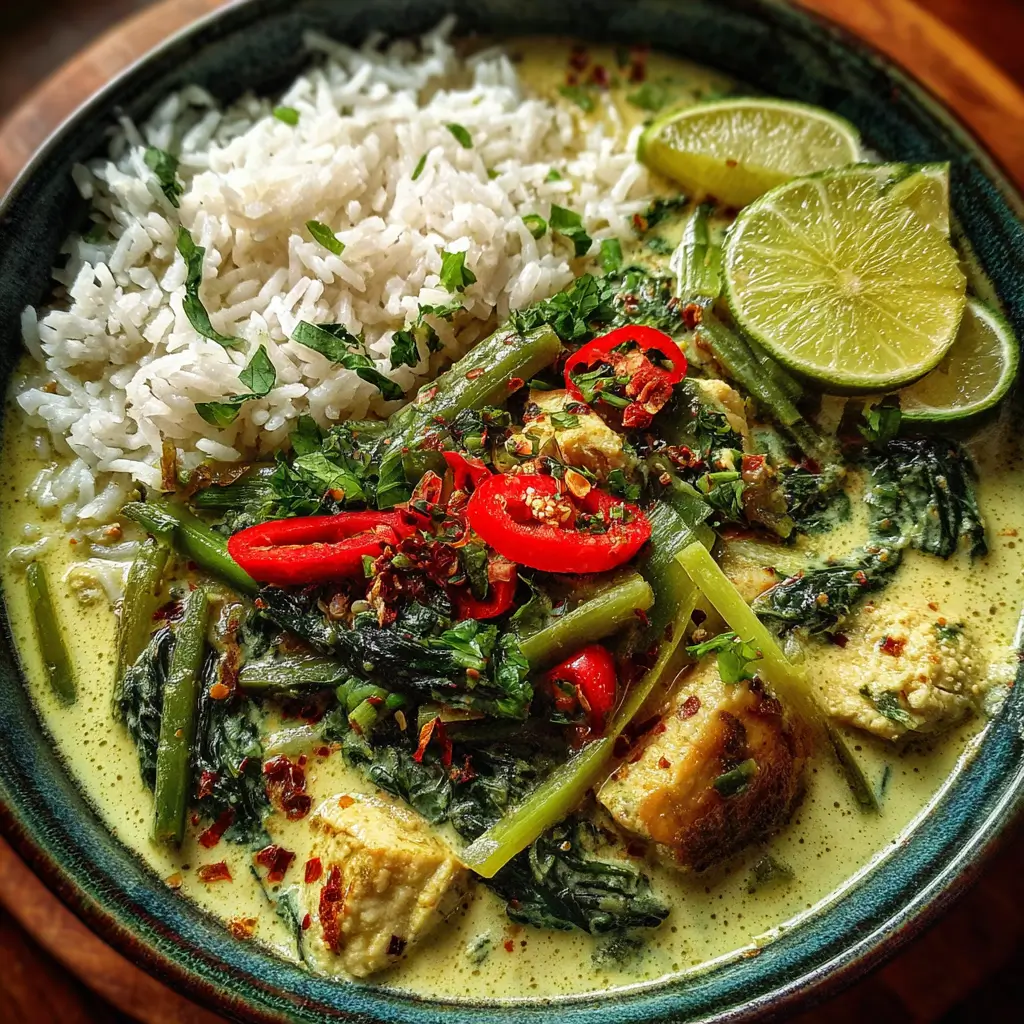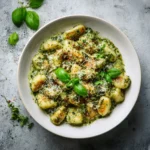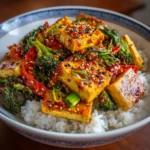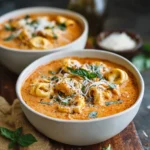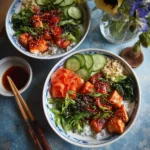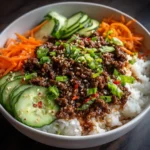Introduction
Vegetarian Thai Green Curry is a vibrant, aromatic, and deeply satisfying dish that brings the essence of Thai cuisine to your kitchen without relying on meat. Known for its creamy coconut base, fragrant green curry paste, and colorful array of fresh vegetables, this plant-based version of a classic Southeast Asian favorite is both nourishing and indulgent. Whether you’re a long-time vegetarian or simply looking to incorporate more plant-based meals into your diet, this curry offers bold flavors, rich textures, and a comforting warmth that makes it perfect for any occasion—from weeknight dinners to weekend feasts with friends and family.
The History
Thai Green Curry, known as Kaeng Khiao Wan in Thai, which translates to “sweet green curry,” has roots tracing back to central Thailand. Unlike red or yellow curries, green curry gets its name and hue from the fresh green chilies used in its preparation—specifically bird’s eye chilies—which are blended into a complex paste along with aromatic herbs like lemongrass, galangal, kaffir lime zest, coriander root, and garlic. Historically, Thai curries were developed as part of a broader culinary tradition emphasizing balance: spicy, sour, sweet, salty, and sometimes bitter elements harmonized in one dish.
While traditional versions often included chicken, fish, or shrimp, vegetarian adaptations have existed for centuries in Buddhist communities where meat consumption was avoided. With globalization and rising interest in plant-based diets, Vegetarian Thai Green Curry has gained widespread popularity across the world. Today, it’s celebrated not only for its delicious taste but also for its adaptability, allowing home cooks to experiment with seasonal vegetables, alternative proteins, and spice levels while honoring its cultural origins.
Ingredients Breakdown
The magic of Vegetarian Thai Green Curry lies in the careful selection and layering of ingredients that create a symphony of flavor. Here’s a detailed breakdown:
- Green Curry Paste: The heart of the dish. Traditionally made from scratch using fresh green chilies, lemongrass, galangal, shallots, garlic, kaffir lime peel, coriander roots, and shrimp paste (not vegetarian). For a vegetarian version, use store-bought or homemade paste omitting shrimp paste or substituting it with miso or soy sauce for umami depth.
- Coconut Milk: Full-fat canned coconut milk provides the luscious, creamy texture essential to the curry. The first pour (thick cream) is often heated first to release its oils and enhance richness before adding the curry paste.
- Vegetables: A rainbow of vegetables adds color, texture, and nutrition. Common choices include bell peppers (red, yellow, green), bamboo shoots, zucchini, baby corn, eggplant, mushrooms (shiitake, oyster, or cremini), and green beans. These are typically added in stages based on cooking time.
- Protein (Plant-Based): Tofu (firm or extra-firm, preferably pressed and cubed), tempeh, seitan, or even chickpeas can be used to add protein. Tofu is most common and absorbs the curry flavors beautifully when pan-seared first.
- Fish Sauce Substitute: Since traditional fish sauce isn’t vegetarian, alternatives like soy sauce, tamari (gluten-free option), or liquid aminos are used to provide the necessary saltiness and umami punch.
- Sweetener: Palm sugar or brown sugar balances the heat and acidity. Palm sugar is preferred for its caramel-like depth, but any natural sugar works.
- Herbs and Aromatics: Fresh Thai basil, kaffir lime leaves, and cilantro are crucial for finishing the dish. Kaffir lime leaves are simmered in the curry to infuse citrusy aroma, while Thai basil is stirred in at the end for a peppery-anise flavor.
- Garnishes: Sliced red chili, chopped cilantro, lime wedges, and fried shallots elevate presentation and add contrasting textures and brightness.
Step-by-Step Recipe
- Prepare Ingredients: Press and cube tofu; slice all vegetables uniformly for even cooking. Measure out coconut milk, sugar, and sauces. If using homemade green curry paste, ensure it’s ready. Have fresh herbs washed and prepped.
- Heat Coconut Cream: Open a can of full-fat coconut milk and scoop out the thick cream from the top (about 1/2 cup). Heat it in a large pot or deep skillet over medium heat. Allow it to simmer gently until it begins to separate and oil starts to pool around the edges—this takes about 3–5 minutes and enhances flavor absorption.
- Bloom the Curry Paste: Add 3–4 tablespoons of green curry paste (adjust to taste) to the hot coconut cream. Stir constantly for 1–2 minutes until the paste becomes highly fragrant. This step unlocks the essential oils in the spices and deepens the overall flavor profile.
- Add Remaining Coconut Milk: Pour in the rest of the coconut milk (including the thinner liquid from the can) and stir well to combine with the bloomed paste. Bring to a gentle simmer.
- Incorporate Aromatics: Add 2–3 torn kaffir lime leaves and a bruised stalk of lemongrass (optional) to the simmering mixture. Let them infuse for 2–3 minutes before removing the lemongrass.
- Add Hard Vegetables First: Introduce longer-cooking vegetables such as carrots, eggplant, or green beans. Simmer for 5–7 minutes until slightly tender.
- Add Softer Vegetables and Protein: Stir in bell peppers, zucchini, mushrooms, baby corn, and bamboo shoots. Gently place in seared tofu cubes. Cook for another 5–7 minutes until vegetables are tender-crisp and tofu is heated through.
- Season the Curry: Add 1–2 tablespoons of soy sauce or tamari and 1 tablespoon of palm sugar. Stir well and taste. Adjust seasoning by adding more sugar for sweetness, soy sauce for saltiness, or lime juice for acidity.
- Finish with Herbs: Remove from heat and stir in a generous handful of fresh Thai basil leaves. Reserve some for garnish. The residual heat will wilt the herbs just enough to release their flavor.
- Serve: Ladle the curry into bowls over steamed jasmine rice or sticky rice. Garnish with sliced red chilies, chopped cilantro, and a lime wedge on the side.
Tips
- Use High-Quality Curry Paste: If making your own, toast whole spices lightly before blending. If buying pre-made, look for brands without shrimp paste or artificial additives.
- Don’t Rush Blooming the Paste: Taking time to sauté the curry paste in coconut cream is critical—it builds layers of flavor that can’t be rushed.
- Control Spice Level: Start with less curry paste and gradually add more. You can always increase heat, but you can’t reduce it once added.
- Balance the Flavors: Always taste before serving. The ideal green curry should have a harmony of spicy, sweet, salty, and tangy notes. A splash of fresh lime juice at the end can brighten the entire dish.
- Avoid Boiling Coconut Milk: Keep the heat at a gentle simmer after adding coconut milk to prevent curdling or separation.
- Prep Ahead: Chop all ingredients before starting. Thai curries cook quickly, so having everything ready ensures smooth execution.
- Let It Rest: Like many stews and curries, flavors deepen if allowed to sit for 10–15 minutes after cooking before serving.
Variations and Customizations
One of the greatest strengths of Vegetarian Thai Green Curry is its versatility. Here are several ways to customize it:
- Low-Fat Version: Use light coconut milk or a blend of coconut milk and vegetable broth. Note: this reduces creaminess but cuts calories significantly.
- Gluten-Free: Ensure soy sauce substitute is gluten-free (tamari or coconut aminos).
- Extra Protein: Add chickpeas, lentils, edamame, or quinoa to boost protein content.
- Winter Variation: Swap in hearty vegetables like sweet potatoes, butternut squash, or kale. Add a touch more sugar to complement their natural sweetness.
- Summer Version: Use lighter vegetables like zucchini, snap peas, and cherry tomatoes. Finish with mint instead of Thai basil for a refreshing twist.
- Creamier Texture: Blend a portion of the cooked vegetables and coconut milk before adding tofu and delicate veggies, then return to the pot.
- Seafood-Inspired (Vegan): Include seaweed strips or nori to mimic oceanic umami, or use vegan “fish” sauce.
- Nut-Free: Traditional green curry is naturally nut-free, but always check labels on store-bought pastes.
- Dairy-Free: This recipe is inherently dairy-free—just confirm all packaged ingredients comply.
- Spice Swaps: For a different kick, add a dash of sriracha or chili oil at the end.
Health Considerations and Nutritional Value
Vegetarian Thai Green Curry can be a nutritious addition to a balanced diet when prepared thoughtfully. Here’s what you need to know:
- Healthy Fats: Coconut milk contains medium-chain triglycerides (MCTs), which are metabolized differently than other fats and may support energy and metabolism. However, it is high in saturated fat, so moderation is advised, especially for those monitoring cholesterol.
- Rich in Vitamins and Fiber: The variety of vegetables provides essential vitamins (A, C, K), antioxidants, and dietary fiber, promoting digestive health and immune function.
- Plant-Based Protein: Tofu or legumes contribute complete or complementary proteins, making this a satisfying main course for vegetarians and vegans.
- Sodium Content: Store-bought curry pastes and soy sauce can be high in sodium. To reduce salt, use low-sodium tamari, make your own paste, or dilute with extra coconut water or broth.
- Sugar Awareness: Palm sugar is natural but still a form of sugar. Reduce or omit if managing blood sugar levels; consider using a small amount of stevia or monk fruit extract as a substitute.
- Anti-Inflammatory Properties: Ingredients like turmeric (often in curry paste), garlic, ginger (galangal), and chili peppers have anti-inflammatory and antioxidant benefits.
- Allergies: Check labels for allergens in commercial curry pastes—some contain shrimp, fish, or gluten. Always opt for certified vegetarian or vegan-labeled products when needed.
Approximate Nutritional Value per Serving (1 bowl with rice):
- Calories: 400–500 kcal
- Protein: 12–18g
- Fat: 25–30g (mostly from coconut)
- Carbohydrates: 35–45g
- Fiber: 6–8g
- Sodium: 600–900mg (varies widely)
Ingredients
- 1 can (13.5 oz / 400 ml) full-fat coconut milk (well shaken)
- 3–4 tbsp vegetarian green curry paste (homemade or store-bought)
- 1 block (14 oz / 400g) firm or extra-firm tofu, pressed and cubed
- 2 cups mixed vegetables (bell peppers, zucchini, mushrooms, green beans, baby corn, eggplant, etc.)
- 1/2 cup bamboo shoots (canned, drained)
- 2–3 kaffir lime leaves, torn
- 1 stalk lemongrass, bruised and cut into 2-inch pieces (optional)
- 1–2 tbsp soy sauce or tamari
- 1 tbsp palm sugar or brown sugar
- 1 handful fresh Thai basil leaves, plus extra for garnish
- 1–2 red chilies, sliced (optional, for garnish)
- Chopped cilantro, for garnish
- Lime wedges, for serving
- Jasmine rice or sticky rice, for serving
Directions
- Press tofu for at least 20 minutes, then cut into 1-inch cubes. Optionally, pan-sear in a non-stick skillet until golden on all sides. Set aside.
- In a large pot or wok, heat the thick coconut cream (top layer from the can) over medium heat for 3–5 minutes until it begins to separate and shimmer.
- Add green curry paste and stir constantly for 1–2 minutes until very fragrant.
- Pour in the remaining coconut milk and stir to combine. Bring to a gentle simmer.
- Add kaffir lime leaves and lemongrass (if using). Simmer for 2–3 minutes to infuse flavor.
- Add harder vegetables (e.g., carrots, green beans, eggplant) and cook for 5–7 minutes.
- Stir in softer vegetables (bell peppers, zucchini, mushrooms, bamboo shoots, baby corn) and cooked tofu. Simmer for another 5–7 minutes until vegetables are tender but not mushy.
- Add soy sauce, sugar, and stir well. Taste and adjust seasoning—add lime juice if desired for acidity.
- Remove lemongrass and discard. Turn off heat and stir in Thai basil until wilted.
- Serve hot over jasmine rice. Garnish with sliced chilies, cilantro, and lime wedges.
FAQ
Is Thai green curry paste vegetarian?
Not always. Many commercial brands contain shrimp paste. Always check the label or make your own to ensure it’s vegetarian.
Can I freeze Vegetarian Thai Green Curry?
Yes, though the texture of coconut milk may separate slightly upon thawing. Reheat gently on the stove, stirring frequently. Add a splash of water or coconut milk if too thick.
What can I use instead of kaffir lime leaves?
Lime zest or a few drops of lime essential oil (food-grade) can mimic the citrusy aroma, though the flavor won’t be identical. Dried kaffir lime leaves are also an acceptable substitute—use 1 dried leaf per 2 fresh.
How spicy is green curry?
It varies by paste and quantity used. Green curry is typically spicier than red or yellow due to fresh green chilies. Adjust the amount of paste to control heat.
Can I use frozen vegetables?
Yes, but add them later in the process to avoid overcooking. Thaw and drain excess water first to prevent dilution.
Is this curry gluten-free?
It can be. Use tamari instead of soy sauce and verify that the curry paste is gluten-free.
What rice pairs best with green curry?
Jasmine rice is traditional—its floral aroma complements the curry perfectly. Sticky rice is also excellent for scooping up sauce.
Summary
Vegetarian Thai Green Curry is a flavorful, aromatic, and adaptable dish that celebrates the harmony of Thai cuisine using plant-based ingredients. Packed with vegetables, creamy coconut milk, and fragrant herbs, it’s a wholesome meal that delights the senses and nourishes the body.
